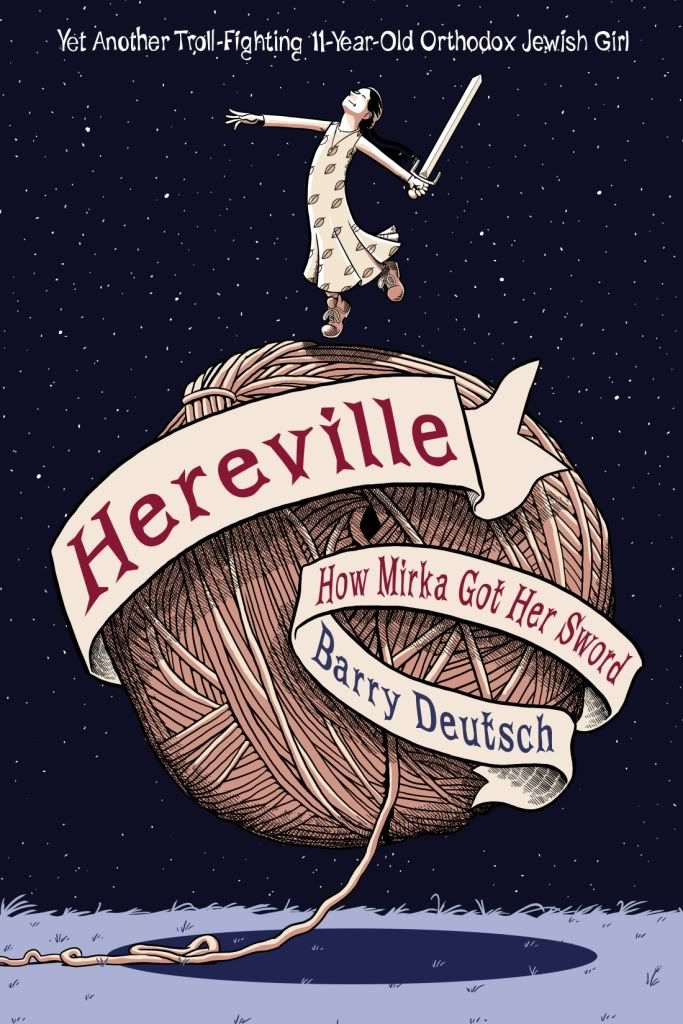I had heard of this book a few times before I found it at the library (I believe over at unshelved and The Enchanted Inkpot ) and it sounded like a fairly interesting book. Specifically, in an interview with the author (Barry Deutsch) he mentioned that his inspiration for the final battle scene came from the two-page spread of ballet in the manga Swan (which I loved) and that turned out to be even more amazing than the interview said it was*.
Hereville: How Mirka Got Her Sword by Barry Deutsch
Summary: Mirka is an orthodox Jewish girl growing up in the Jewish village of Hereville but she wishes that her life was a bit more adventurous. In fact, she wishes to go dragon slaying and after an encounter with a witch and her talking pig she might just get her wish.
The Good: Most middle grade^ and YA books don't deal with religion at all so it's interesting to see a story not only make religion a major theme in the book but to also make it a really accessible story for anyone who isn't an orthodox Jew. The story doesn't shy away from using Yiddish vocabulary in the character's speech (which helpful notes at the bottom of each page) and it's clear that the religion is a big part of all the character's lives and really does influence in them (ie, religion is the setting for this story and works beautifully as one). Mirka is a fun protagonist who does some stupid things for very understandable reasons and acts like a real kid would, really hoping that Deutsch publishes more stories about her.
The Bad: There are a few plotholes in the book, or at least details that aren't fully explained. Mirka's stepmother warns her away from the witch quite vehemently but never offers any explanation for why she reacted that strongly. Was it just because she was a witch or was there a deeper reason as well? Also, at one point Mirka's mother appears to her and she spends some time worrying that her mother is an unhappy ghost and her stepmother just waves it off, saying that "when people hold their breath for a very long time they see some very strange things. " Again, was that all there was to it or was there more to Mirka's vision? Yes it's explained but it's not satisfying to see a one panel explanation for a multi-page problem.
The Art: The art leans more towards Western comics than manga but the art style feels very distinctly it's own. It's a color comic but most pages use a color scheme based around shades of one color (such as orange or purple) and this helps give the story more of a fairy feeling. The lines are smooth and the simplistic designs are consistent, it feels like the perfect artwork for this story.
This book actually reminded me of a lot of books I read back in middle school (back when I got a lot of my reading recommendations from the amazing literary magazine Cricket) and I would have loved this just as much back then as I did last week. It's not a "must buy!" for me but I'll certainly keep an eye out for it and try to grab a copy sometime.
*Additionally, if he thinks the two page spread ballet "fights" in Swan are interesting he should really check out Princess Tutu since that takes the idea and runs with it even farther.
^recently I read that "middle grade" books are actually books for high school students, not middle school students as I had previously thought (since, you know, they both have the word "middle" in them). However, since I've said before that YA books are not about "young adults" (people over the age of 18 but not much more) but rather "children"-who-are-almost-adults I'll continue to call books aimed more at the 11-14 year old crowd "middle grade" books.
